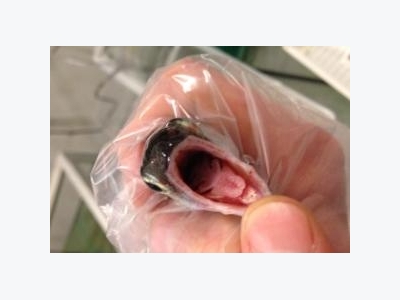3D-scans may help curb widespread fish disease

A reddening of the mouth and jaw area is the hallmark symptom of enteric redmouth disease. (Photo: The University of Copenhagen)
The bacterium that causes enteric redmouth disease can now be tracked with a special 3D scanner. “The scans exceed our wildest dreams,” say researchers.
We often hear that there are too many antibiotics in agriculture. This is actually also the case in fish farming, where 75 percent of the antibiotics are used to fight the widespread fish disease enteric redmouth disease.
The disease is not harmful to humans but it can increase mortality and reduce well-being in fish.
Having scanned rainbow trout with a so-called OPT scanner (Optical Projection Tomography), Danish scientists have now figured out how the deadly bacteria infect the fish.
Fish infected through the gills
”The new scans show us that the fish are infected through their ultra-thin gills,” says Maki Otani, a postdoc fellow at the Department of Veterinary Disease Biology at the University of Copenhagen.
The rainbow trout’s gills are a specialised organ whose chief function is to absorb oxygen from the water so the fish can breathe. Only two cell layers separate the outer water from the blood in the fish’s small arteries.
The new findings show that the bacterium infects the fish via a specific cell type in the gills.
As little as one minute after the bacterium is introduced into the aquaculture, its presence can be registered in the fish’s bloodstream. The bacterium subsequently infects the fish via its intestine and the lateral line canal – a sensory apparatus running along both sides of the body.
Findings may reduce antibiotics use
The OPT scanner is a rare piece of equipment that enables scientists to monitor the infection with unparalleled precision.
The new scans show us that the fish are infected through their ultra-thin gills. Maki Otani
“Our findings are presumably the first of their kind and the scanning images exceed our wildest dreams,” explains Associate Professor Martin Raida, also of the Department of Veterinary Disease Biology, who headed the study, published in the journal Plos One.
The researchers believe the new findings may make it easier to develop a better vaccine to fight the dangerous bacterium, and that could eventually reduce antibiotics use in fish farms.
Related news
 Functional fish feeds, gut health, novel proteins: experts to weigh in on hot topics
Functional fish feeds, gut health, novel proteins: experts to weigh in on hot topics We will hear how nutrigenomics can foster sustainable aquaculture, along with a new model to evaluate gut health and growth in salmon.
 Yeast digestibility hinders effectiveness of novel protein based fish feed
Yeast digestibility hinders effectiveness of novel protein based fish feed Research, just published, evaluating a mussel and yeast based feed for Arctic charr found it restricted fish growth.
 Swine liver hydrolyzate could work as a substitute for fishmeal in fish feeds
Swine liver hydrolyzate could work as a substitute for fishmeal in fish feeds Swine liver hydrolyzate can be included in carnivorous fish diets but free amino acids limits the inclusion level, say researchers.